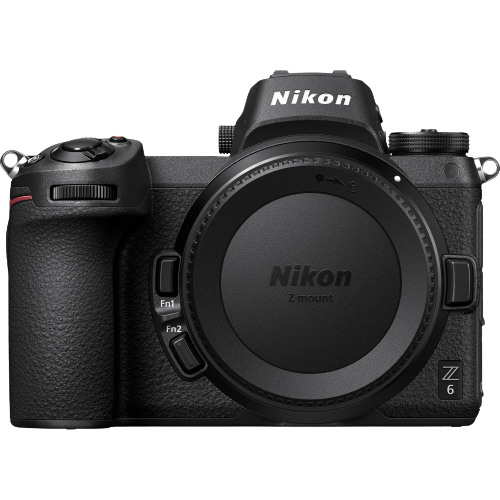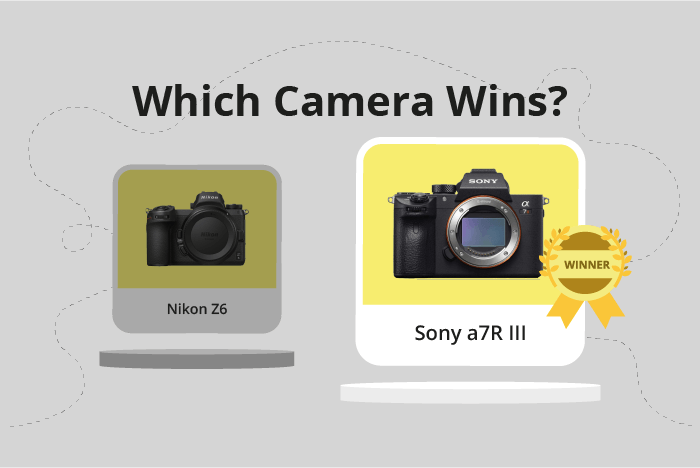Nikon Z6 vs Sony a7R III Comparison
Nikon Z6

Sony a7R III

The Nikon Z6 and Sony a7R III are both mirrorless cameras that share many similarities, but the Sony a7R III takes the lead with a score of 83/100, just 2 points ahead of the Nikon Z6’s 81/100. Both cameras were released in 2017-2018 with the Sony a7R III being slightly more expensive at $3200 compared to the Nikon Z6’s $2000 launch price. In terms of size and weight, the Sony a7R III is slightly smaller and lighter, measuring 127 x 96 x 74mm and weighing 657g, while the Nikon Z6 measures 134 x 101 x 68mm and weighs 675g.
The Sony a7R III outperforms the Nikon Z6 in certain aspects, such as its higher score and more compact design. On the other hand, the Nikon Z6 stands out with its more affordable price, making it a better option for budget-conscious consumers. Both cameras offer impressive features, and the choice between the two ultimately depends on individual preferences and needs.
Nikon Z6 vs Sony a7R III Overview and Optics
The Sony a7R III emerges as the winner in optics, scoring 84/100, while the Nikon Z6 receives a score of 83/100. Both cameras share common specifications, such as CMOS sensor type, full-frame sensor size, and image stabilization. Additionally, they have their own lens mounts – Nikon Z for the Z6 and Sony FE for the a7R III.
The Sony a7R III outperforms the Nikon Z6 in certain aspects. It boasts a higher megapixel count of 42.4, compared to the Z6’s 24.5, resulting in more detailed images. Moreover, its sensor achieves a DXOMARK score of 100, outshining the Z6’s score of 95. These features contribute to the a7R III’s superior image quality and resolution.
On the other hand, the Nikon Z6 excels in shooting speed, capturing 12 frames per second, while the a7R III manages 10 frames per second. This advantage makes the Z6 more suitable for fast-paced photography, such as sports and wildlife.
In terms of optics, both cameras have their strengths and weaknesses. The Sony a7R III’s higher megapixel count and DXOMARK score make it the better choice for photographers seeking high-resolution images. However, the Nikon Z6’s faster shooting speed may appeal to those who prioritize capturing fast-moving subjects.
Considering these factors, the choice between the Nikon Z6 and Sony a7R III ultimately depends on the specific needs and preferences of the photographer. The a7R III takes the lead in image quality, while the Z6 offers an advantage in shooting speed.
Nikon Z6 vs Sony a7R III Video Performance
The Nikon Z6 outperforms the Sony a7R III in video capabilities, with a video score of 83/100 compared to the Sony’s 56/100. Both cameras have 4K video resolution and maximum video dimensions of 3840 x 2160, but the Nikon Z6 excels in other aspects.
The Nikon Z6 boasts a maximum video frame rate of 60fps, which is double the Sony a7R III’s 30fps. This significant difference allows the Nikon Z6 to capture smoother and sharper footage, especially in fast-paced or action scenes. The Nikon Z6 also has time-lapse functionality built-in, which the Sony a7R III lacks. This feature makes the Nikon Z6 a more versatile option for videographers who want to create time-lapse videos without needing additional equipment or software.
The Sony a7R III, on the other hand, does not have any particular advantages over the Nikon Z6 in terms of video capabilities. Its lower frame rate and lack of time-lapse functionality make it less appealing for videographers who require these features. However, it still offers 4K video resolution and the same maximum video dimensions as the Nikon Z6, making it suitable for those who do not need the additional features of the Nikon Z6.
Comparing the video capabilities of the Nikon Z6 and Sony a7R III, the Nikon Z6 is the clear winner with its higher frame rate and built-in time-lapse functionality. The Sony a7R III falls short in these areas, making it a less versatile option for videographers. However, both cameras still offer 4K video resolution and large video dimensions, making them viable choices for high-quality video capture.
Nikon Z6 vs Sony a7R III Features and Benefits
The Nikon Z6 is the winner in the features comparison, scoring 87/100, while the Sony a7R III scores 83/100. Both cameras have a touchscreen, GPS, WIFI, and Bluetooth. They differ in screen size, screen resolution, and the presence of a flip screen.
The Nikon Z6 has a larger screen size of 3.2 inches compared to the Sony a7R III’s 3 inches. This larger screen allows for better image viewing and menu navigation. Additionally, the Z6 has a higher screen resolution of 2,100,000 dots, providing a clearer and sharper display compared to the a7R III’s 1,440,000 dots.
The Sony a7R III, however, has a flip screen, a feature the Nikon Z6 lacks. This flip screen is beneficial for photographers who want flexibility in composing shots from various angles. The presence of a flip screen is the main advantage the Sony a7R III holds over the Nikon Z6.
Considering each camera’s strengths and weaknesses, the Nikon Z6 is superior in terms of screen size and resolution. These features contribute to a better overall user experience while shooting and reviewing images. The Sony a7R III’s flip screen is its main advantage, offering flexibility in certain shooting scenarios. However, this single advantage is not enough to surpass the Nikon Z6’s overall better performance and higher feature score.
Nikon Z6 vs Sony a7R III Storage and Battery
The Sony a7R III outperforms the Nikon Z6 in storage and battery, scoring 65/100 compared to the Z6’s 35/100. Both cameras share the feature of USB charging, but the similarities end there.
The a7R III holds a significant advantage with its dual memory card slots, accepting SD, SDHC, and SDXC cards, all UHS-II compatible. This provides more storage options and flexibility. In contrast, the Z6 only has a single memory card slot, accepting XQD cards. Additionally, the a7R III boasts a longer battery life, capable of capturing 650 shots with its NP-FZ100 battery, while the Z6 can only manage 310 shots using its EN-EL15b battery.
The Nikon Z6 does have one advantage over the Sony a7R III: USB charging. This feature allows for convenient charging on the go. However, this does not make up for its shortcomings in storage capacity and battery life.
Ultimately, the Sony a7R III provides superior storage options and longer battery life, making it the better choice for photographers who require more flexibility and longer shooting sessions. The Nikon Z6’s USB charging feature is a nice addition, but its limited storage and battery life hinder its overall performance in comparison.
Nikon Z6 vs Sony a7R III – Our Verdict
Are you still undecided about which camera is right for you? Have a look at these popular comparisons that feature the Nikon Z6 or the Sony a7R III:

